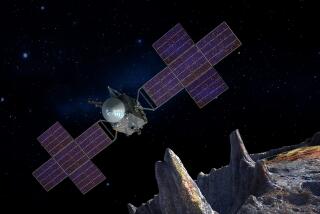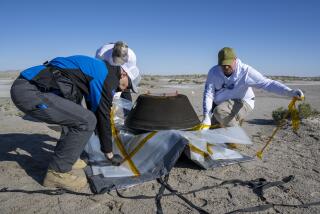Science / Medicine : Meteorite Makes an Impact : Discovery: Evidence of a collision 65 million years ago on Yucatan Peninsula bolsters theory about the extinction of dinosaurs, experts say. The event briefly emptied the Gulf of Mexico.
Fourteen years after he stumbled upon a clue that launched one of the centuryâs most vigorous scientific debates, UC Berkeley geologist Walter Alvarez headed to a remote region of Mexico in February hoping to resolve that debate. What he sought were ancient signs of immense destruction, and he was not disappointed.
In a startling discovery, Alvarez and three colleagues found what appears to be the most complete evidence to date that an asteroid or comet, perhaps about six miles in diameter, smashed into the Gulf of Mexico 65 million years ago. The impact, they conclude, briefly emptied the basin as it sent a half-mile-high tidal wave ripping across the land.
Heat from such an event would have sent firestorms raging throughout much of the Western Hemisphere and spewed a cloud of dust and smoke into the air, plunging the Earth into a prolonged winter and delivering a death blow to much of life at the time the dinosaurs disappeared.
The new evidence comes from a site that once formed part of the Gulf of Mexico sea floor. The region, which rose long ago when land was pushed up and the sea level lowered, lies near the coast, north of Tampico in a brushy river area called Arroyo de Mimbral.
The scientists found, stacked atop one another along the Mimbral riverbank, long-lost chapters in a story of catastrophe. In the rocks above and below the telltale section lie fossilized marine microorganisms typical of a placid sea undisturbed for many millions of years.
But just at the layer known as the Cretaceous/Tertiary, or K/T, boundary that marks the time when the dinosaurs and more than half of all species of land and sea organisms died out, the scientists discovered what may be the most telling evidence yet of the devastating effect of an extraterrestrial impact. The record of destruction includes scars from tidal waves and chunks of trees that smashed into the ancient seabed when it lay a full 2,000 feet below the surface of the Gulf.
The team reported the discovery in March at the Lunar and Planetary Science conference in Houston. âThis is just the sort of evidence weâve all been looking for,â Alvarez said. âIt makes the impact theory look better and better.â
Other evidence bolstering Alvarezâs conclusion was also reported at that meeting, including the presence of so-called âshockedâ quartz spheres that are considered unequivocal evidence of a meteorite impact. That evidence may even reveal the precise site of the impact. Satellite imagery studied by Charles Duller of NASAâs Ames Research Center in Mountain View reveals a 125-mile-diameter ring of water-filled sinkholes on the Yucatan Peninsula that he thinks marks the boundary of the crater left by the meteorite.
Not everyone accepts the meteorite impact theory of extinction of the dinosaurs. Other researchers insist that volcanic eruptions may have produced the smoke cloud that plunged the Earth into the equivalent of a ânuclear winter,â or that the climate changed for reasons that had nothing to do with either volcanoes or meteorite impacts.
But the identification of a specific large crater dated to the time of the dinosaur extinction provides strong evidence in favor of the meteorite theory. Even if the impact was not the sole cause of the extinction, said NASAâs Duller, it âwould have had a devastating effect on climate, animals and plant life of the Earth.â
If Alvarez sounds eager about the new results, he has good reason. In 1977, he returned to Berkeley with some clay he had found embedded in the ancient pink limestone of the northern Italian Apennines, and soon this clay layer became celebrated evidence of an unwelcome extraterrestrial visit that changed the history of the Earth.
Alvarez, along with his father, the late physics Nobel laureate Luis Alvarez, and two nuclear chemists, discovered that the clay contained an unusually high concentration of the rare element iridium. The concentration--100 to 1,000 times what is normally found on Earth--was close to that found in extraterrestrial sources.
Because the age of the clay layer coincided with the 65-million-year-old mass extinctions at the K/T boundary, the Alvarez team concluded in 1980 that the iridium was the sign that remained from a massive impact marking the end of the dinosaursâ long reign and radically changing the pattern of life on land and in the sea.
They predicted that more signs of the impact would be found in similar iridium-rich deposits worldwide, and since their initial discovery, Alvarez and other scientists have found the iridium layer in three dozen sites, from New Mexico to Denmark to South Africa. Soon the search began for the site of the impact itself.
Late last year, Glen Penfield, a consulting geophysicist from Perkasie, Pa., and the University of Arizonaâs Alan Hildebrand deduced from detailed rock analyses and studies of unusual magnetic and gravity properties that the Yucatan Peninsula region was a likely site of a massive K/T boundary impact. This stirred Alvarez into action.
If a giant asteroid hit the Yucatan Peninsula, Alvarez and his colleagues figured, then there should be unmistakable signs of its destruction nearby. Modern-day exposures of rocks 65 million years old are rare, but a report from the 1930s indicated a promising area just 500 miles from the Yucatan site. Here, north of Tampico, at the Tropic of Cancer, neither erosion, exuberant tropical vegetation nor the movement of the Earthâs tectonic plates have masked the evidence. This is where Alvarez, Dutch colleague Jan Smit and two Berkeley post-doctoral researchers headed in February.
What they uncovered after a few false starts, with the aid of a machete, is what post-doctoral researcher Alessandro Montanari calls the geological âTreasure of the Sierra Madre.â
At the bottom of the outcrop lie rocks studded with spherical remnants of what may have been glass produced by the blast, possibly rained down on Earth after the asteroid impact melted and vaporized huge amounts of rock. Glass spherules have been identified at other sites--most recently in Haiti--as strong evidence of a massive impact. Although the Mimbral spherules no longer retain their glassy origins, they are the right size and shape, and the bed is particularly thick, as would be expected near the asteroid or comet impact site.
The next layer reveals the unlikely mixture of marine deposits, boulders, exotic materials and pieces of fossilized wood, which form a coarse-grained block. This discovery of tree remnants mixed with the ancient seabed is perhaps the most striking evidence of the devastation.
The block shows rippled or laminated layering, suggesting that the seabed itself, about 2,000 feet below the surface of the Cretaceous sea, was somehow smashed by waves at the time the material was deposited. Perhaps the impact-triggered tsunami not only ripped off coastal vegetation, the scientists suggest, but slammed the slurry of tree debris, mud, boulders and marine sediment back down onto the sea floor.
Atop the block lies a multilayered section that appears to have been formed by turbulent waves swaying to and fro. This indicates that these deposits may have been laid down by oscillating waves that ricocheted back and forth across the Gulf region after the impact, âlike water sloshing back and forth in a bathtub before it settles down,â Montanari said.
What makes the Mexican discovery an even more convincing sign of K/T boundary destruction is that both directly below and above the intensely disrupted region lie marine sediments representing placid conditions lasting for many millions of years before and after the period of catastrophe.
âAbove and below, this is a typical deep-water sequence, with boring old shale and foraminifera,â said Nicola Swinburne, a post-doctoral scientist with Alvarez at UC Berkeley and the fourth discoverer of the Mimbral site. âJust at one point out of 30 million years--just at the K/T boundary--you find this anomalous bed of material. Its presence fits so well with the theory that at the K/T boundary there was one cataclysmic, sudden event.â
Perhaps the most convincing evidence of the meteorite impact is the semicircular ring of sinkholes centered around the Mexican town of Chicxulub. The sinkholes, which average 300 to 500 feet in diameter, were apparently formed when underground water forced its way up through limestone fractured by the meteorite impact. As the limestone was eaten away, the ground collapsed, producing the sinkholes.
With all this new evidence, the scientists are able to outline an earth-wrenching scenario of events that changed the world:
About 65 million years ago, a huge asteroid hurtling through space smashed into Yucatan. The impact melted and vaporized rock, which condensed and rained down over a wide area, forming the spherule bed at the bottom of the Mimbral site. At the same time, the impact forced so much water out of the Gulf of Mexico that the sea floor was temporarily exposed.
A 2,000-foot-high tidal wave tore across the Gulf of Mexico and up the nearby coast. Such staggering dimensions are consistent with the hypotheses of other scientists who have calculated that a 6-mile-wide asteroid or comet would hit the Earth with 100 million megatons of explosive power--10,000 times the total 1990 world nuclear arsenal.
As the tidal wave advanced, it brought with it debris ripped up along its violent path, then slammed the slurry back down onto the sea floor. This formed the block of tree and sea floor material found atop the spherules. Finally, the water sloshed back and forth within the Gulf of Mexico as the effects of the cataclysm began to subside. This âbathtubâ effect would explain the finer, multilayered signs of wave turbulence found at the upper portion of the Mimbral outcrop.
Some details of the scenario may change as more research is done, but the signs of catastrophe are unmistakable. âLast yearâs Yucatan impact hypothesis says if you go to the area nearby in Mexico, youâre going to find all kinds of wave disturbances at the Cretaceous/Tertiary boundary, and man, thatâs what weâre finding all over the place,â Alvarez said.
Penfield, who pinpointed the Yucatan Peninsula as a likely impact site, said that like the glass spherules discoveries in Haiti, âthe Mimbral site is a scientific treasure. I expect in the next 10 years, we may find quite a few more sites.â
Charting a Meteorite
Some scientists believe that a meteorite smashed into the Gulf of Mexico near Merida about 65 million years ago. Evidence supporting that theory has been located in a region called the Arroyo de Mimbral, which once formed part of the sea floor.






